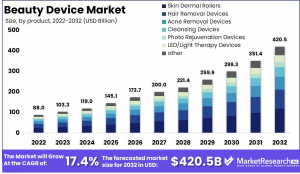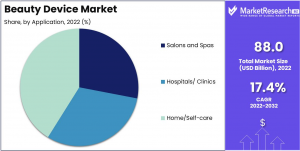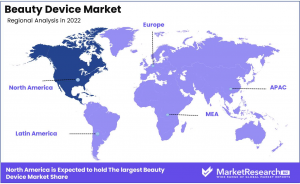Beauty Device Market to Reach USD 420.5 Bn by 2032, Expanding at 17.4% CAGR
Beauty Device Market size is expected to be worth around USD 420.5 Bn by 2032 from USD 88.0 Bn in 2022, growing at a CAGR of 17.4%
North America’s continued dominance is driven by technological advancements, innovation across industries, and business-friendly policies promoting sustained growth.
”
NEW YORK, NY, UNITED STATES, January 29, 2025 /EINPresswire.com/ -- Market Overview— Tajammul Pangarkar
Beauty Device Market size is expected to be worth around USD 420.5 Bn by 2032 from USD 88.0 Bn in 2022, growing at a CAGR of 17.4% during the forecast period from 2023 to 2032.
The Beauty Device Market encompasses a broad range of electronic and handheld devices used in personal care and cosmetic applications. These devices include tools for skin care, hair removal, anti-aging treatments, and other beauty-related functions. They leverage advanced technologies like radio frequency, light therapy, ultrasound, and laser to deliver results at home or in professional settings. With growing consumer interest in self-care and beauty innovation, the market for such devices continues to expand globally.
The Beauty Device Market has witnessed significant growth over the past few years, fueled by increasing consumer awareness of self-care and the growing demand for convenient at-home beauty treatments. With continuous advancements in technology, beauty devices are becoming more sophisticated, offering professional-level results at affordable prices. This shift is not only democratizing beauty treatments but also reducing dependency on in-clinic services. Consumers now expect efficiency, safety, and ease of use from these devices, creating a strong opportunity for manufacturers to innovate and differentiate their products.
Governments in key markets are also playing a role by investing in the wellness sector and supporting the development of beauty tech. Increased regulatory scrutiny in terms of safety standards for such devices has also prompted manufacturers to enhance their compliance frameworks, ensuring better consumer trust and higher market acceptance. These trends point to a bright future for the beauty device market, where both established and emerging players can capitalize on the growing demand.
The Beauty Device Market has experienced a robust growth trajectory due to a combination of factors. Rising disposable incomes, changing beauty standards, and heightened consumer interest in personal wellness have all contributed to this market expansion. Governments across developed and emerging markets are recognizing the potential of the beauty and wellness industry, leading to increased investments in this sector. In addition, favorable regulations around consumer safety and product efficacy have spurred innovation in the development of safer, more effective beauty devices. However, as regulatory frameworks evolve, companies will need to stay updated on compliance requirements, particularly related to product safety and health claims, to avoid costly penalties or delays in market entry.
For both new and existing players in the Beauty Device Market, there are substantial opportunities for growth. New entrants can focus on creating innovative, affordable devices tailored to the unique needs of different consumer segments. By leveraging emerging technologies such as artificial intelligence and personalization, businesses can differentiate themselves. Existing players can enhance their product lines by integrating advanced features or expanding into new geographic regions, capitalizing on the global shift toward at-home beauty treatments. Collaboration with influencers, improved digital marketing strategies, and direct-to-consumer models will also enable faster market penetration and deeper customer engagement.
Curious About Market Trends? Request Your Complimentary Sample Report Today: https://marketresearch.biz/report/beauty-device-market/request-sample/
Key Takeaway
--The Beauty Device Market is projected to grow from USD 88.0 Bn in 2022 to USD 420.5 Bn by 2032 (CAGR 17.4%), driven by technological advancements, increasing aging population, and demand for home beauty solutions.
--Technology & Innovation: AI-powered skincare, LED therapy, micro-needling, and laser treatments are transforming the market. Devices offering non-invasive anti-aging, acne removal, and hair removal solutions are gaining traction.
--Rise of Home-Use Beauty Devices: Consumers prefer cost-effective, time-saving solutions at home over salon visits. Social media influence and digital beauty trends are accelerating adoption.
--Sustainability & Regulation: Demand for eco-friendly beauty devices is rising. Regulatory frameworks are evolving, impacting product safety, efficacy, and transparency in the market.
--North America (25% share) leads, followed by Europe and Asia-Pacific. APAC is the fastest-growing region, fueled by rising disposable income and beauty-conscious consumers.
Use Cases
At-Home Skincare Devices At-home skincare devices, such as facial cleansing brushes, LED masks, and microdermabrasion tools, have gained immense popularity due to their convenience and ease of use. These devices enable consumers to perform professional-grade skincare treatments in the comfort of their own homes, leading to cost savings and personalized skincare routines.
Hair Removal Devices Hair removal devices, like laser and IPL (intense pulsed light) devices, have revolutionized the beauty industry by offering long-term hair removal solutions at home. Consumers are increasingly choosing at-home devices due to their cost-effectiveness and the privacy they offer compared to salon treatments. These devices cater to individuals looking for painless and efficient ways to remove unwanted hair.
Anti-Aging Devices Anti-aging beauty devices, including radiofrequency (RF) skin therapy machines, ultrasonic devices, and microcurrent facial tools, are popular among consumers looking for non-invasive treatments to reduce fine lines and wrinkles. These devices stimulate collagen production, improving skin texture and elasticity, and are becoming a regular part of consumers' at-home skincare regimens.
Professional Beauty Devices for Salons Beauty salons and spas invest in high-end, professional beauty devices for treatments like microblading, dermal needling, and skin rejuvenation. These devices enable salons to offer advanced, effective services that cater to customers seeking more targeted, personalized beauty treatments. The demand for such equipment is growing as clients increasingly seek non-invasive, high-tech options for skin care.
Fitness and Wellness Devices Fitness-focused beauty devices, such as vibration platforms, body sculpting machines, and facial massagers, are gaining traction in the wellness sector. These devices promise benefits like improved circulation, muscle toning, and facial rejuvenation, catering to individuals who are not only looking to enhance their appearance but also improve overall health and well-being.
Driving Factors
Growing Consumer Interest in At-home Beauty Treatments: With the increasing focus on self-care and convenience, consumers are seeking at-home beauty solutions that allow them to replicate salon-like experiences. Beauty devices such as facial steamers, hair removal devices, and skin rejuvenation tools are gaining popularity as consumers prefer the convenience of at-home treatments.
Technological Advancements in Beauty Devices: The integration of cutting-edge technology, such as LED therapy, microcurrent, and sonic vibration, into beauty devices has enhanced their effectiveness. As devices become more sophisticated and offer better results, the market for beauty devices continues to grow.
Increased Focus on Personalization and Customization: Consumers are looking for personalized beauty routines. Devices that cater to individual skin types, hair textures, and beauty goals, such as customizable facial devices or hair treatments, are becoming more popular, driving growth in the beauty device market.
Rise of Social Media Influencers and Beauty Trends: Social media platforms like Instagram, TikTok, and YouTube have made beauty influencers and at-home beauty routines more mainstream. The promotion of beauty devices by influencers is driving consumer interest and sales, making these products a must-have for many beauty enthusiasts.
Growing Middle-Class Population and Disposable Income: In emerging markets, particularly in Asia-Pacific, rising disposable incomes and the expanding middle class are leading to increased spending on beauty and personal care products. This trend is contributing to the growth of the beauty device market as consumers are more willing to invest in high-quality devices for their beauty routines.:
Report Segmentation
By Product Type
• Oxygen and Steamer Devices
• Hair Removal Devices
• Acne Removal Devices
• Hair Growth Devices
• LED/Light Therapy Devices
• Cleansing Devices
• Photo Rejuvenation Devices
• Skin Dermal Rollers
• Cellulite Reduction Devices
By Application
• Salons and Spas
• Hospitals/ Clinics
• Home/Self-care
Ready to Act on Market Opportunities? Buy Your Report Now and Get 30% off: https://marketresearch.biz/purchase-report/?report_id=37007
Regional Analysis
As 2022 approaches, North America continues to dominate global revenue share, with forecasts indicating that this trend will persist over the projected period. The region's revenue share is expected to reach 25% by 2022, reflecting its strong economic influence on the global market.
Several factors contribute to this remarkable growth, including political stability, technological advancements, and continuous innovation across industries. The region’s thriving digital economy, strong R&D ecosystem, and business-friendly policies further strengthen its market position.
For market players, North America's sustained dominance presents both opportunities and challenges. Companies looking to expand in the region must leverage cutting-edge technologies, align with regulatory policies, and capitalize on consumer trends to stay competitive. With ongoing scientific progress and disruptive innovations, North America is poised to remain a major global economic powerhouse in the coming years.
Growth Opportunities
Increasing Demand for At-Home Beauty Treatments: Consumers are increasingly looking for professional-grade beauty treatments at home. This growing preference for at-home skincare and beauty devices, such as facial cleansing brushes and LED light therapy tools, presents a major growth opportunity for beauty device manufacturers.
Technological Innovations in Beauty Devices: The continuous advancements in technology are driving the development of more effective beauty devices. Innovations such as AI-powered skincare analysis or smart hair removal tools offer opportunities to create cutting-edge products that meet consumers' growing beauty needs.
Rise in Male Grooming Market: The male grooming industry is expanding, with more men investing in beauty and skincare products. This shift opens up a new market segment for beauty devices tailored specifically to male consumers, such as beard trimmers or hair removal devices.
Increasing Focus on Anti-Aging Products: As consumers age, the demand for anti-aging beauty devices, such as facial massagers and wrinkle-reducing tools, is growing. Companies can cater to this demand by developing devices that target skin rejuvenation, making them a popular choice among older consumers.
E-commerce Growth: The growing trend of purchasing beauty products online presents a unique opportunity for beauty device companies to expand their reach. Selling through e-commerce platforms allows businesses to access a global customer base and increase sales of beauty devices.
Key Players
• Panasonic Corporation
• Nu Skin Enterprises, Inc.
• The Procter & Gamble Company
• Syneron Medical Ltd.
• PhotoMedex, Inc.
• L'Oréal S.A.
• TRIA Beauty, Inc.
• Koninklijke Philips N.V.
• Home Skinovations Ltd.
• Carol Cole Company, Inc.
Not Sure? Request a Sample Report and See How Our Insights Can Drive Your Business: https://marketresearch.biz/report/beauty-device-market/request-sample/
Conclusion
In conclusion, the markets analyzed are all experiencing growth driven by evolving consumer preferences, technological advancements, and increasing demand for customized, high-quality products. Key trends, such as the adoption of sustainable practices, integration of smart technologies, and rising disposable incomes, are shaping the competitive landscape. While challenges such as market saturation, price sensitivity, and regional differences persist, opportunities abound for companies to capitalize on niche segments, leverage digital platforms, and innovate to meet the specific needs of their target audiences. As these industries continue to expand, businesses that adapt to changing trends, prioritize customer-centric strategies, and invest in innovation will be well-positioned for long-term success.
Lawrence John
Prudour
+91 91308 55334
email us here
Legal Disclaimer:
EIN Presswire provides this news content "as is" without warranty of any kind. We do not accept any responsibility or liability for the accuracy, content, images, videos, licenses, completeness, legality, or reliability of the information contained in this article. If you have any complaints or copyright issues related to this article, kindly contact the author above.



